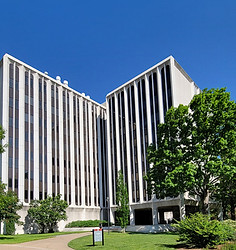Research Overview
Research in the Shaw lab is currently divided into three areas: (1) ribosome heterogeneity, (2) de novo antibody structure characterization, (3) instrumentation.

(1) Ribosome heterogeneity: understanding of ribosome composition and function is undergoing a paradigm shift from a static automaton to dynamic molecular machine with many unique forms conferring specialized biological function. However, the size and complexity of the ribosome (2.5-4.5 MDa, 50-80 ribosomal proteins, 3-4 rRNA strands, numerous transiently associated proteins) precludes direct characterization by traditional biophysical methods.The combination of top-down proteomics and native mass spectrometry is uniquely capable of providing the key information needed to elucidate the connection between structure and function of the ribosome. Native MS enables direct measurement of the intact ribosome and provides information on subunit stoichiometry, topology, and ligand binding. Top-down proteomics provides a much more detailed characterization of the combinatorial nature of modifications that produce the active forms (i.e. proteoforms) of ribosomal and ribosome associated proteins. This combination will enable us to rapidly characterize the ribosome as a function biological state and initiate/inform targeted high-resolution structure determination by cryo-EM to gain understanding of function.

(2) De novo antibody structure characterization: antibodies are a critical component of the human immune system that provide a specific response to infectious agents, and monoclonal antibodies are among of the most common and successful biotherapeutics for wide range of diseases. The specificity of antibodies is afforded by hypervariable regions known as the complementarity determining regions (CDRs). The sequence variability of the CDRs that is critical for a broadly effective yet antigen specific immune response creates an enormous analytical challenge regarding identification and characterization of the subset of antibodies responsible for an immune response. We are developing and applying new top-down proteomics workflows to enable streamlined discovery and characterization of novel antibody therapeutics.

(3) Instrumentation: this research area is focused on the development hardware, instrument control, and methods for novel approaches to tandem mass spectrometry (MS/MS), ion mobility spectrometry (IMS), and data acquisition. In practice, these projects are spun up independently then integrated with the application oriented research areas above. The goal of these developments is to enable more effective characterization of protein/complex mass, protein sequence, posttranslational modifications (PTMs), ligand binding, and higher order structure. We approach these challenges from an array of directions including, gas-phase charge manipulation (ion-ion or ion-electron reactions), gas-phase fragmentation (MS/MS using photodissociation, ion-ion/electron reactions), and gas-phase separations (IMS).






